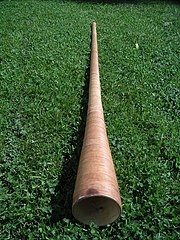Lur
This article needs additional citations for verification. (June 2011) |

A lur, also lure or lurr, is a long natural blowing horn without finger holes that is played with a brass-type embouchure. Lurs can be straight or curved in various shapes. The purpose of the curves was to make long instruments easier to carry (e.g. for marching, like the modern sousaphone) and to avoid directing the loud noise at nearby people.
The name lur is used for two distinct types of ancient
Wooden lurs
The earliest references to an instrument called the lur come from
A kind of lur very similar to these war instruments has been played by farmers and milkmaids in Nordic countries since at least the Middle Ages.[2] These instruments, called in English a birch trumpet, were used for calling cattle and signalling. They are similar in construction and playing technique to the war instrument, but are covered in birch, while the war instruments are covered in willow.
Bronze lurs
Lurs made of bronze were used as musical instruments in ancient Greece, as well as in northern Europe where a total of 56 lurs have been discovered: 35 (including fragmentary ones) in Denmark, 11 in Sweden, 4 in Norway, 5 in northern Germany, and a single one in Latvia.
Lurs today
The word lur is still in the Swedish language, indicating any funnel-shaped implement used for producing or receiving sound. For instance, the Swedish word for headphones is hörlurar (hearing-lurs), and a telephone might be referred to as a lur in contemporary Swedish (derived from telefonlur, telephone handset). The Norwegian and Swedish words for foghorn are respectively tåkelur and mistlur. The Danish butter brand Lurpak is named after the lur, and the package design contains pictures of lurs.
The word lur has several other meanings in Danish, Norwegian, and Swedish that are not related to sound.
See also
References
- ^ "Bronze lurs - The Brudevælte lurs". Archived from the original on 2011-09-27. Retrieved 2007-10-21.
- ^ "The Wooden Lurs". ojtrumpet.net. Archived from the original on 2019-10-11. Retrieved 2019-10-11.
